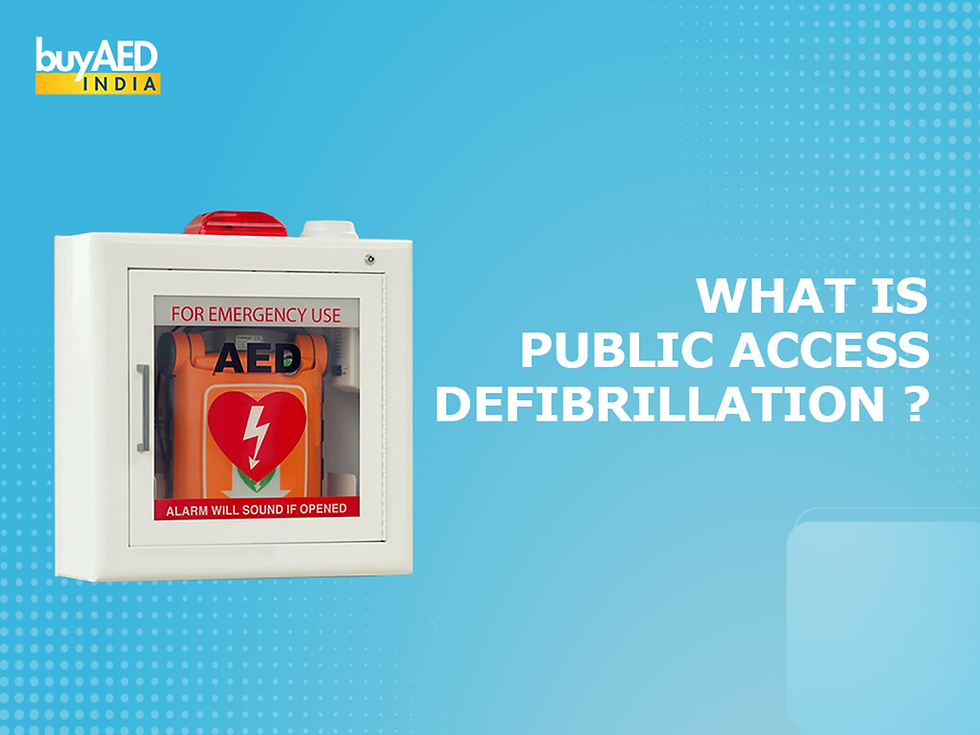Everything You Need to Know About Cardiac Science Defibrillators (AEDs)
- Dr. Shruti Shah

- Jun 16
- 5 min read

Sudden cardiac arrest is a serious medical emergency that could happen to me or you at any place at any time.
In the absence of immediate assistance, chances of survival decrease by 10% in one minute.
This is why having a good Automated External Defibrillator on site can mean the difference between life and death.
Cardiac Science is a top brand that is well known for its industry-leading quality AEDs designed for professional and public use.
Their AEDs truly are a global standard because of their dependability, ease of operation, and cutting-edge technology.
If you are looking to purchase a Cardiac Science AED anywhere in India, BuyAEDIndia has an extensive selection of models suitable for use at homes, offices, public places, and even medical institutions.
This is a step-by-step guide that covers everything you need to know about Cardiac Science AEDs' features, benefits, types, usage, and maintenance.
What is a Cardiac Science Automated External Defibrillator (AED)?
A Cardiac Science AED is a portable medical device used to assess the condition of the heart and provide an electric shock if needed, to assist in regaining a normal heartbeat during sudden cardiac arrest.
This AED has automatic safeguards that protect against shock delivery to ensure their effectiveness and safety regardless of the user’s level of training.
They are commonly found in:
Offices and workplaces
Schools and universities
Airports, malls, and public places
Hospitals and ambulances
Gyms and sports centers
Homes (for high-risk individuals)
Why Choose Cardiac Science AEDs?
Cardiac Science AEDs are known for their reliability, durability, and advanced features that enhance survival chances in a cardiac emergency.
Key Benefits of Cardiac Science AEDs:
User-Friendly Design: Easy-to-follow voice and visual instructions guide users step by step.
Fully Automatic & Semi-Automatic Options: Choose between a fully automatic AED (delivers shock without pressing a button) or a semi-automatic AED (requires pressing a shock button).
Patented Rescue Ready Technology: The AED performs daily, weekly, and monthly self-checks to ensure it’s always ready to use.
Clear Voice Prompts & Visual Cues: Clear voice and visual instructions are provided to all responders whether trained or untrained overcoming high-stress situations.
Durable & Rugged Build: Designed to withstand extreme temperatures, shocks, and dust for reliable performance.
Pediatric Mode Available: Instantly change from adult to child mode without the need to interchange electrode pads.
High-Quality Battery Life: Long-lasting batteries ensure AEDs are ready when needed.
Types of Cardiac Science AEDs

Cardiac Science offers different AED models to meet various needs. Here are the most popular models:
Fully automatic & semi-automatic options
Provides real-time CPR feedback to ensure proper chest compressions
Clear voice prompts and LED indicators for guidance
Rugged, dustproof, and water-resistant design
Fast shock delivery within 10 seconds
Best for: Schools, offices, public spaces, sports facilities
2. Cardiac Science Powerheart G3 AED
Easy-to-use, with intuitive voice and visual prompts
Automatic self-testing ensures readiness
One-button operation for simple use
Available in both automatic and semi-automatic models
Best for: Homes, small businesses, first responders
3. Cardiac Science Powerheart G3 Elite AED
Advanced technology for professional responders
Fully automatic shock delivery with no-button operation
High durability, suitable for harsh environments
Fast response time and precise shock delivery
Best for: Hospitals, ambulances, emergency medical teams
4. Cardiac Science Powerheart G5 Trainer AED
Non-shocking AED designed for training purposes
Mimics real AED functions for hands-on CPR and AED training
Adjustable training scenarios for realistic practice
Best for: CPR instructors, medical training centers
Key Features to Look for in a Cardiac Science AED
Before purchasing an AED, consider these essential features:
1. Automatic vs. Semi-Automatic AED
Fully automatic AEDs deliver a shock automatically if needed.
Semi-automatic AEDs require the user to press a button to deliver the shock.
2. CPR Feedback System
Many Cardiac Science AEDs provide real-time feedback on chest compression depth and rate, ensuring effective CPR.
3. Daily Self-Checks (Rescue Ready Technology)
Cardiac Science AEDs perform automatic self-tests to check battery, electrode pads, and system readiness.
4. Pediatric Mode
AEDs with pediatric functionality allow switching to a lower energy level for child victims without changing pads.
5. Rugged and Durable Build
Power heart AEDs are shockproof, dustproof, and water-resistant, making them ideal for both indoor and outdoor use.
6. Long Battery Life
AED batteries last 4-7 years and can deliver multiple shocks during emergencies.
How to Use a Cardiac Science AED?

Cardiac Science AEDs are designed for ease of use. Follow these steps during an emergency:
Step 1: Turn on the AED
Press the power button or open the lid (some models power on automatically).
Step 2: Attach Electrode Pads
Place the electrode pads on the bare chest as shown on the AED.
Step 3: Let the AED Analyze
The AED will analyze the heart rhythm and determine if a shock is needed.
Step 4: Deliver the Shock (If required)
Fully Automatic AED: Delivers the shock automatically.
Semi-Automatic AED: Instructs the user to press the shock button.
Step 5: Perform CPR
Follow voice instructions for chest compressions and rescue breaths until medical help arrives.
Maintenance & Care for Your Cardiac Science AED
To ensure your AED is always ready for use, follow these maintenance tips:
Check the Status Indicator: Cardiac Science AEDs have a status light to show if they’re ready to use.
Replace Batteries on Time: Batteries last 4-7 years but should be replaced before expiration.
Check & Replace Electrode Pads: Pads expire every 2-3 years and must be replaced as needed.
Perform Regular Inspections: Ensure there are no visible damages and that all accessories are in place.
Store in an Accessible Location: Place the AED in a visible and easily reachable spot.
Where to Buy Cardiac Science AEDs in India?
Looking for Cardiac Science AEDs in India?
Buy AED India offers:
Genuine Cardiac Science AEDs at competitive prices
Expert advice to help you choose the right model
Accessories like pads, batteries, and carrying cases
Fast shipping across India
Conclusion
Cardiac Science AEDs are life-saving devices designed for quick and effective defibrillation during sudden cardiac arrest.
Whether for homes, offices, schools, hospitals, or public places, these AEDs provide reliable and easy-to-use solutions for emergency situations.
If you’re looking to purchase a Cardiac Science AED in India, check out BuyAEDIndia for the best options, expert guidance, and top-quality service. Be prepared, save lives!
FAQs
1. What is a Cardiac Science AED?
A portable device that delivers a shock to restore normal heart rhythm during sudden cardiac arrest.
2. Who can use a Cardiac Science AED?
Anyone, as it provides clear voice and visual instructions.
3. Which model is best for public places?
The Powerheart G5 AED is ideal for offices, schools, and public areas.
4. How long does the Cardiac Science AED battery last?
Cardiac Science AED batteries last 4-7 years in standby mode.
5. Do AED pads expire?
Yes, they expire every 2-3 years and should be replaced on time.
6. Can I use the Cardiac Science AED on children?
Yes, with pediatric pads or settings for child use.
7. Does the Cardiac Science AED need maintenance?
Minimal, with self-checks and occasional pad/battery replacements.
8. Is the Cardiac Science AED waterproof?
Many models are water-resistant and durable for outdoor use.
9. Where should I store a Cardiac Science AED?
In a visible, accessible location like offices, schools, or public areas.
10. Where can I buy a Cardiac Science AED in India?
Get it from BuyAEDIndia for authentic products and expert support.
If you are confused about finding one that offers both quality and affordability, don’t forget to check out Cardiac Science Defibrillators from Buy AED India, which will meet your needs.





Comments